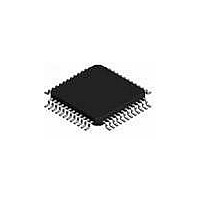L6711TR STMicroelectronics, L6711TR Datasheet - Page 36

L6711TR
Manufacturer Part Number
L6711TR
Description
IC CTRLR 3PHASE VID/DACS 48-TQFP
Manufacturer
STMicroelectronics
Type
Step-Down (Buck)r
Datasheet
1.L6711TR.pdf
(50 pages)
Specifications of L6711TR
Internal Switch(s)
No
Synchronous Rectifier
No
Number Of Outputs
1
Voltage - Output
0.8 ~ 1.55 V
Current - Output
2A
Frequency - Switching
150kHz
Voltage - Input
12V
Operating Temperature
0°C ~ 70°C
Mounting Type
Surface Mount
Package / Case
48-TQFP Exposed Pad, 48-eTQFP, 48-HTQFP, 48-VQFP
Power - Output
2.5W
Output Voltage
0.8 V to 1.581 V
Output Current
95 A
Input Voltage
13.8 V
Mounting Style
SMD/SMT
Maximum Operating Temperature
+ 125 C
Minimum Operating Temperature
0 C
Lead Free Status / RoHS Status
Lead free / RoHS Compliant
Other names
497-5363-2
L6711TR
L6711TR
Available stocks
Company
Part Number
Manufacturer
Quantity
Price
Output voltage monitor and protections
14.5.2
36/50
This happens when the on-time limitation is reached after the valley current in each phase
reaches I
The device enters in Quasi-Constant-Current operation: the low-side mosfets stays ON until
the current read becomes lower than I
side mosfet can be then turned ON with a T
off and the device works in the usual way until another OCP event is detected.
This means that the average current delivered can slightly increase in Quasi-Constant-
Current operation since the current ripple increases. In fact, the ON time increases due to
the OFF time rise because of the current has to reach the I
condition is when the ON time reaches its maximum value.
When this happens, the device works in Constant Current and the output voltage decrease
as the load increase. Crossing the UVP threshold causes the device to latch driving high the
OSC pin
It can be observed that the peak current (Ipeak) is greater than I
determined as follow:
Where Vout
threshold is crossed, all mosfets are turned off, the FAULT pin is driven high and the device
stops working. Cycle the power supply or the OUTEN pin to restart operation.
The maximum average current during the Constant-Current behavior results:
In this particular situation, the switching frequency for each phase results reduced. The ON
time is the maximum allowed (T
The transconductance resistor Rg can be designed considering that the device limits the
bottom of the inductor current ripple and also considering the additional current delivered
during the quasi-constant-current behavior as previously described in the worst case
conditions.
Moreover, when designing D-VID compatible systems, the additional current due to the
output filter charge during dynamic VID transitions must be considered.
Constant current operation
I
I
T
Rg
PEAK
MAX,TOT
OFF
=
=
I
-------------------------------------------------------------------- -
=
OCPx max
L
I
(Figure 18
OCPx
OC Px
=
Ipeak I
------------------------------------ -
3 I
MIN
I
OC TH min
+
(I
MAX
V
is the UVP threshold, (inductor saturation must be considered). When that
INFOx
V
------------------------------------- - Ton
out
–
IN
R
OCPx
SENSE max
=
–
shows this working condition).
Vout
> I
3
L
OCTH
⎛
I
OCPx
MI N
).
F
where
+
onMAX
=
Ipeak I
------------------------------------ -
---------------------------------------
T
MAX
onMax
) while the OFF time depends on the application:
I
OCPx
OCPx
2
–
=
1
OCPx
I
+
OCPx
T
(I
ON
=
OFF
INFOx
⎞
⎠
I
-------------------------- -
imposed by the control loop after the LS turn-
OUT OCP
+
V
------------------------------------- - 0.40 T
I N
< I
3
–
OCTH
Vout
L
–
----------- -
) skipping clock cycles. The high
MIN
OCPx
I
2
PP
+
bottom. The worst-case
OCPx
I
------------- -
D-VID
3
but it can be
SW
L6711














